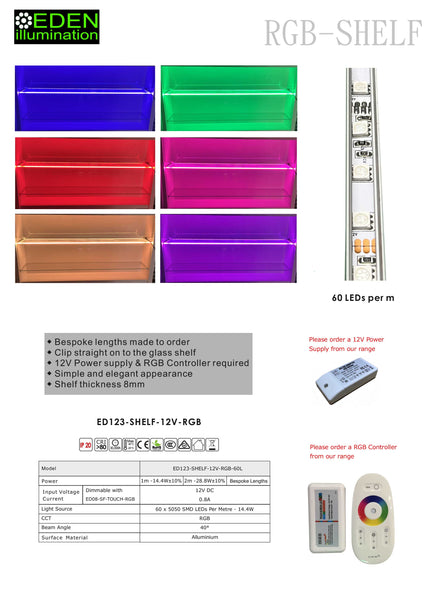LED Lighting Glossary
Please find an explanation of some of the LED lighting terms used within our website (source: Wikipedia)
LUMENS
The lumen (symbol: lm) is the SI derived unit of luminous flux, a measure of the total "amount" of visible light emitted by a source.
LUX
The lux (symbol: lx) is the SI unit of illuminance and luminous emittance, measuring luminous flux per unit area. It is equal to one lumen per square metre. In photometry, this is used as a measure of the intensity, as perceived by the human eye, of light that hits or passes through a surface. It is analogous to the radiometric unit watts per square metre, but with the power at each wavelength weighted according to the luminosity function, a standardized model of human visual brightness perception.
LED
A light-emitting diode (LED) is a semiconductor light source. LEDs are used as indicator lamps in many devices and are increasingly used for other lighting. Appearing as practical electronic components in 1962, early LEDs emitted low-intensity red light, but modern versions are available across the visible, ultraviolet, and infrared wavelengths, with very high brightness. When a light-emitting diode is switched on, electrons are able to recombine with holes within the device, releasing energy in the form of photons. This effect is called electroluminescence and the colour of the light (corresponding to the energy of the photon) is determined by the energy band gap of the semiconductor. An LED is often small in area (less than 1 mm2), and integrated optical components may be used to shape its radiation pattern. LEDs present many advantages over incandescent light sources including lower energy consumption, longer lifetime, improved physical robustness, smaller size, and faster switching. However, LEDs powerful enough for room lighting are relatively expensive and require more precise current and heat management than compact fluorescent lamp sources of comparable output.
CRI
The colour rendering index (CRI), sometimes called colour rendition index, is a quantitative measure of the ability of a light source to reproduce the colours of various objects faithfully in comparison with an ideal or natural light source. Light sources with a high CRI are desirable in colour-critical applications such as photography and cinematography. It is defined by the International Commission on Illumination as follows:
Colour rendering: Effect of an illuminant on the colour appearance of objects by conscious or subconscious comparison with their colour appearance under a reference illuminant
The CRI of a light source does not indicate the apparent colour of the light source; that information is under the rubric of the correlated colour temperature (CCT).
CRI's ability to predict color appearance has been criticized in favour of measures based on colour appearance models, such as CIECAM02 and, for daylight simulators, the CIE Metamerism Index. CRI is not a good indicator for use in visual assessment, especially for sources below 5000 kelvin (K).
Numerically, the highest possible CRI is 100, for a blackbody (incandescent lamps are effectively blackbodies), dropping to negative values for some light sources. Low-pressure sodium lighting has negative CRI; fluorescent lights range from about 50 for the basic types, up to about 90 for the best tri-phosphor type.
RGB
Red, Green, Blue - Multi-colour LEDs offer not merely another means to form white light but a new means to form light of different colours. Most perceivable colours can be formed by mixing different amounts of three primary colours. This allows precise dynamic colour control. As more effort is devoted to investigating this method, multi-colour LEDs should have profound influence on the fundamental method that we use to produce and control light colour.
KELVIN(K)
Kelvin temperature is a numerical measurement that describes the colour appearance of the light produced by the lamp and the colour appearance of the lamp itself, expressed on the Kelvin (K) scale. In application, the Kelvin temperature of lamps is used to categorize them as warm, neutral or cool sources. The terms are not directly related to temperature; instead, they describe how the light source appears visually. Warm sources actually have a lower colour temperature (3500K or less), producing a red-yellow appearance. Neutral sources (between 3500K and 4100K) tend to have a yellow appearance. A lamp with a colour temperature of 5000K is considered pure white light (Full Spectrum) with the lamp becoming bluer in colour as the colour temperature is increased. Warm light sources are traditionally used for applications where warm colours or earth tones dominate the environment, and where there is a need to impart a feeling of comfort, cosiness and relaxation. Cool light sources (5000K+) with high colour rendering capabilities, such as Full Spectrum lights, are traditionally used for applications where there is a need to enhance all colours equally, such as retail stores to stimulate sales, or to increase productivity and reduce errors within the office environment and to motivate the customer or employee through enhanced "see-ability".
COB
COB refers to Chip on Board, a new technology of LED packaging for LED light. When Multi LED chips are packaged together as one lighting module and lit up they seem to look like a single LED.





